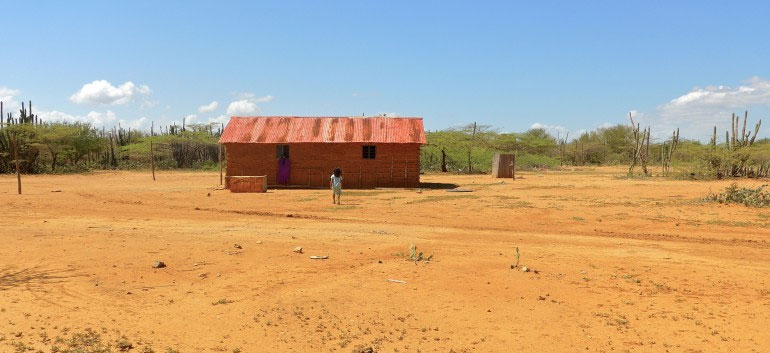President Juan Manuel Santos visited Colombia’s northernmost state on Friday, where residents have been dying due to drought, political apathy, and the mismanagement of public funds.
La Guajira |
In his first act as president after inauguration, Santos landed in La Guajira with members of the Colombian Air Force to carry tons of food, water, and medicine to communities suffering from thirst and malnutrition, Caracol Radio reported.
Often called Colombia’s richest state for the presence of El Cerrejon, Latin America’s largest coal mining operation, La Guajira also has double the child mortality rate of any other state in the country, and in some cases, triple.
MORE: Indigenous communities in Colombia’s north experiencing a famine: Ombudsman
Over 50% of the population of La Guajira is indigenous, and lives in roughly 3000 different communities called “rancherias” scattered throughout the state.
The largely desert territory faces a maelstrom of problems such as drought, corruption, and lack of transportation infrastructure.
The entire state lacks potable water, including the capital, Riohacha, where water is only available in plastic bags sold at stores.
Last week, the Ministry of Housing released a statement promising to help the desert communities, where nearly 3,000 children have died in the last six years due to disease and starvation.
MORE: ‘We need help;’ north Colombia children starving to death
Corruption and mismanagement
According to Senator and former governor of La Guajira Jorge Ballesteros, the state of La Guajira already receives millions in government resources each year, but only around 3o% actually reaches the desert communities.
MORE: Colombia builds new wells, but indigenous desert communities have no access: leaders
In May, the Senator told Colombia Reports that corruption in the allocation of government resources plays a heavy role in the current crisis. Meanwhile, community leaders, activists, and indigenous authorities insist that the local government is “stealing” money meant for basic needs, such as electricity and water.
A senate debate led by Ballesteros concluded in a promise of more government funds, but no measures were adopted to address the institutional oversight that causes 70% of government resources to get lost on the way to remote communities in need.
“The state of La Guajira receives billions and billions of dollars each year,” former vice-presidential candidate Aida Avella told Colombia Reports.
“Everyone wonders why the richest state in Colombia doesn’t even have an aqueduct in Riohacha [state capital],” said the leftist politician.
Avella asserted that local officials have turned hunger and thirst into a business, accusing politicians of “buying votes with water.” Some intermediaries charge communities money for tankers that bring water to rancherias, which have already been paid for by the state.
“The resources that are sent to La Guajira stay in the local government offices, they do not reach the communities,” said Inis Perez,
According to the national census, 4,151 children died between 2011 and 2013, 278 from starvation, and 2,671 from other largely preventable diseases. Former governor of La Guajira Jorge Ballesteros claims that 98.5% of those children were indigenous.
MORE: Mismanagement of public funds fueling famine in northern Colombia: Senator
A July report by the Ombudman’s office stated that 26 children died last year due to thirst and malnutrition, but the Superintendant of Health believes the actual number to be higher as many indigenous Wayuu often bury their children on their land without reporting the death.
MORE: 15 children dead from thirst, disease in drought-stricken northern Colombia
Mining
While El Cerrejon uses 4.4 million gallons of water a day, the average Guajira resident has access to less than 4.4 pints a day, according to a statement by the Lawyer’s Collective, a Colombian non-governmental human rights organization.
For over 30 years, indigenous and Afro-Colombian communities living in the department of La Guajira have been forced to live with the dire consequences of Latin America’s largest coal mine, which occupies over 170,000 acres in La Guajira. The coal mine operates 24 hours a day, and has caused permanent contamination of the air, soil and water. These effects have generated cumulative damage to the territories, and caused multiple illnesses in surrounding communities.
The Lawyer’s Collective, along with several local community leaders, is demanding that the Cerrejon suspend its activities while the drought continues.
“This situation has gone on for years,” said Governor of the indigenous Wayuu reservation in Hato Nuevo, southern Guajira. “Before the Cerrejon, the land was cultivated…there were crops, there was food, the streams had water.”
Recent Promises
Minister of Housing Luis Felipe Henao Cardona promised last week to drill 20 new wells in central and upper Guajira. The next step, said Henao, is to create a water treatment plant. Henao emphasized that La Guajira has already received $72.8 million USD for water projects from the national government,.
However, most of the existing wells in La Guajira are empty despite being fully functional, according to a July Ombudsman report. Of 350 wells built in the municipality of Uribia, only one one currently has water as a result of a complete lack of rainfall in recent months.
Sources
- Interview with Senator Jorge Ballesteros (Colombia Reports)
- Interview with Aida Avella (Colombia Reports)
- MiniViviendas anuncia la perforacion de 20 pozos mas de agua subterrania (Ministry of Housing press release)
- Presidente Santos visitará La Guajira en su primer acto del nuevo Gobierno (Caracol Radio)
- El mayor gesto de solidaridad con la Guajira: Exigir que el Cerrejón suspenda su actividad durante la sequía (Colectivo de Abogados)
- Entrega de ayuda humanitaria a La Guajira, primer acto de gobierno de Santos (Diario del Huila)
- Interview with Inis Perez (Colombia Reports)


